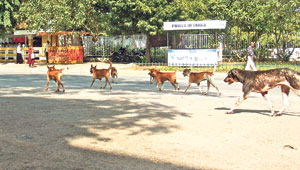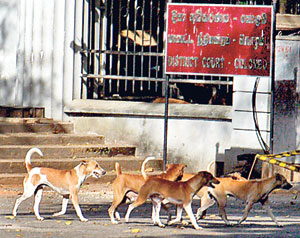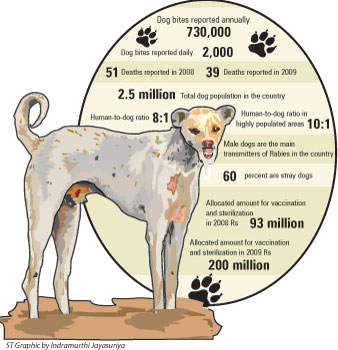The country is experiencing yet another shortage of anti-rabies vaccines, raising fears of an increase in the spread of hydrophobia (rabies) around the country. There were two such shortages last year.
In 2008, 51 people died after being bitten by rabid dogs. This year, 39 deaths from rabid dog bite have been reported so far.
According to veterinary statistics, every year a staggering 730,000 cases of dog bite are reported across the country, with some 2,000 bites reported daily. The treatment of dog-bite victims costs the state more than Rs. 200 million each year.
 |
| Sixty per cent of the country’s 2.5 million canine population are strays. |
 |
Some 60 per cent of the country’s dog population of 2.5 million are strays, while 20 per cent are ownerless domestic dogs (dogs that initially had a home and were subsequently abandoned or went astray.)
A delay in the import of anti-rabies vaccines means a heightening of the rabies risk. Meanwhile, trained persons employed under the anti-rabies programme are standing by, without work, waiting for the vaccines.
“About 400 vaccinators have had no work for more than a month,” said veterinary surgeon Dr. Chamith Nanayakkara. “They are waiting for vaccines ordered from India by the Ministry of Health. If shortages like this keep recurring, disrupting the vaccination programme, there will be an inevitable increase in the spread of rabies. The government should make sure there is a sufficient stock of the vaccines all year round.”
Dr. Nanayakkara is a member of the Association of Veterinarians for the Humane Management of the Animal Population. The association is responsible for close to 90 per cent of the vaccinations conducted around the country.
The Anti-Rabies Vaccine (ARV) the Anti-Rabies Serum (ARS) are used to treat rabies victims. The ARS treatment costs the government Rs. 35,000 per person, while each ARV vaccine is Rs. 2,000.
Last year, 123,124 vials of ARS and 486,240 vials of ARV were administered to rabies victims, according to the Medical Supplies Division of the Ministry of Health. This year, the country imported a total of 83,248 vials of ARS and 218,216 vials of ARV.
“Surgery on bitches is the best long-term solution to the control of the dog population,” Dr. Nanayakkara said. “Females account for 85 per cent of the stray dog population. Male dogs are cited in the majority of dog bite cases. It is just as important to neuter the male dogs as it is to neuter the females. The incidence of dog bites is especially high among males, who turn aggressive when they are in heat.”
The Ministry of Health decided last week to end its programme for neutering male dogs. But veterinary experts say this is not a good decision.
Orchectomy, the surgical removal of the testicles, has many benefits, according to veterinary surgeons. It helps to control aggressive animal behaviour, reduces the incidence of impregnation and undesirable sexual behaviour, as well as urine marking. The most important benefit, of course, is that it helps to check the spread of rabies.
Dr. Nanayakkara said an increase in the number of strays has been observed in the East and the North, and that the dog population in the dry zone was growing fast.
According to Dr. P. A. L. Harischandra, director of the Public Health and Veterinary Health Service, supplies of the rabies vaccine have been held up because of a delay on the part of the importer. He said arrangements were under way to expedite the import of the vaccine.
Meanwhile, the Ministry of Health maintains that the neutering of female dogs is more effective than the neutering of males in the overall battle to control the spread of rabies.
“We used to spend Rs. 250 million every year to neuter male dogs, but we didn’t see any significant drop in the incidence of rabies. Nor was there a significant drop in stray dog population numbers,” Dr. P. A. L. Harischandra said.
Garbage is another aspect of the problem.
According to Dr. S. D. Elleperuma, chief veterinary surgeon for the Colombo Municipal Council, garbage in the city attracts stray dogs from outside city limits. Most of these animals have not been vaccinated.
“There are some 14,000 domestic dogs and 5,000 stray dogs in the city of Colombo,” Dr. S. D. Elleperuma said. “We are struggling to control the spread of rabies, but this is becoming increasingly difficult because in many areas there’s no proper system of garbage disposal.”
Stressing the importance of the neutering programme, Dr. S. D. Elleperuma said that one un-neutered female dog and its descendents could generate up to 67,000 pups over a period of six years. Public support was crucial in the control of the stray dog population, he said. |



